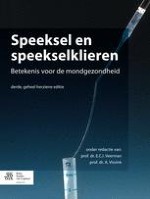2014 | OriginalPaper | Hoofdstuk
11. Speeksel en wondgenezing
Auteurs : H.S. Brand, E.C.I. Veerman
Gepubliceerd in: Speeksel en speekselklieren
Uitgeverij: Bohn Stafleu van Loghum
Samenvatting
-
Speeksel zorgt voor een vochtig milieu in de mond, wat het proces van wondgenezing bevordert. Bovendien bevat speeksel een verscheidenheid aan eiwitten die direct of indirect betrokken zijn bij de wondgenezing.
-
Opiorfinen in speeksel kunnen de werking van natuurlijke pijnstillers verlengen.
-
De stolling van bloed wordt bevorderd door tissue factor in speeksel.
-
Speeksel bevat verschillende groeifactoren: EGF, TGF-α, VEGF, IGF, NGF, FGF en HGF. De concentraties EGF en TGF-α in speeksel worden beïnvloed door levensstijl, leeftijd en systemische ziekten. Hoewel deze groeifactoren bij de mens in speeksel in lage concentraties aanwezig zijn, zouden sommige ervan een rol kunnen spelen bij de bescherming van het mondepitheel en wondgenezing.
-
Secretory leukocyte protease inhibitor (SLPI) kan het enzym elastase remmen, wat bindweefselafbraak voorkomt.
-
Trefoil factor 3 en histatinen versnellen wondsluiting. Histatinen zijn relatief eenvoudige chemische verbindingen, die gemakkelijk in grote hoeveelheden geproduceerd kunnen worden, zodat zij mogelijk zijn toe te passen als wondgenezing bevorderende geneesmiddelen.
-
Cystatinen remmen virussen, afbraak van collageen en botresorptie. De concentratie cystatine C in speeksel stijgt tijdens gingivitis en parodontis.
